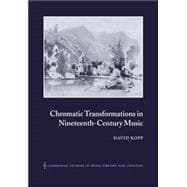
Note: Supplemental materials are not guaranteed with Rental or Used book purchases.
Purchase Benefits
What is included with this book?
| 1. Common-tone tonality | |
| 2. Three examples of functional chromatic mediant relations in Schubert | |
| 3. Key harmonic systems and notions of third relations from Rameau to Hauptmann | |
| 4. Hugo Riemann | |
| 5. Twentieth-century theory and chromatic third relations | |
| 6. Riemann's legacy and transformation theories | |
| 7. A chromatic transformation system | |
| 8. Chromatic mediant relations in musical contexts | |
| 9. Five analyses. |
The New copy of this book will include any supplemental materials advertised. Please check the title of the book to determine if it should include any access cards, study guides, lab manuals, CDs, etc.
The Used, Rental and eBook copies of this book are not guaranteed to include any supplemental materials. Typically, only the book itself is included. This is true even if the title states it includes any access cards, study guides, lab manuals, CDs, etc.